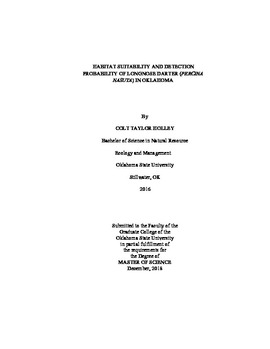| dc.contributor.advisor | Long, James M. | |
| dc.contributor.author | Holley, Colt Taylor | |
| dc.date.accessioned | 2019-07-19T14:08:45Z | |
| dc.date.available | 2019-07-19T14:08:45Z | |
| dc.date.issued | 2018-12-01 | |
| dc.identifier.uri | https://hdl.handle.net/11244/320961 | |
| dc.description.abstract | North America has more than 700 species of freshwater fish that are considered imperiled and at least 27 species of North American fish have gone extinct within the last century. In Oklahoma, the Longnose Darter (LND) is a state-endangered fish species that was presumed extirpated from much of its range in Oklahoma for almost 70 years. Efforts to translocate this species in the 1990s went unassessed and their current distribution in Oklahoma is largely unknown. My objectives were to create ecological niche models at two spatial scales to identify potentially suitable habitat for LND and to sample two streams thought to contain LND in an occupancy modeling framework to estimate detection probability. The program Maxent was used to estimate probability of habitat suitability throughout the historical range of LND using a presence-only approach. This model identified several streams in Oklahoma with high probability of habitat suitability that have not previously been targeted for sampling for LND. After selecting 32 sites in Lee Creek and Blackfork Creek in Oklahoma, darter species were sampled with a backpack electrofisher in the summer of 2017 and spring 2018. No LND were found during the sampling in Blackfork Creek where LND were translocated in the 1990s. In Lee Creek, Longnose Darters were still extant, but had the lowest detection probability (5-10%) among co-occurring darter species depending on season. Compared to summer, the detection probability for LND in spring was not only higher, but more LND were found and at more sites. Presumably, the increased catches and detection of LND in spring was related to spawning activity, when the darters are shallower and more concentrated. Future monitoring for this state-endangered species can take advantage of this information and should be conducted in a way that considers imperfect detection. The range-wide ecological niche model results can be used to target new streams in Oklahoma for sampling for LND and the results from Lee Creek suggest that these surveys would maximize the potential for documenting this species if sampling were conducted in the spring when detection rates are higher. | |
| dc.format | application/pdf | |
| dc.language | en_US | |
| dc.rights | Copyright is held by the author who has granted the Oklahoma State University Library the non-exclusive right to share this material in its institutional repository. Contact Digital Library Services at lib-dls@okstate.edu or 405-744-9161 for the permission policy on the use, reproduction or distribution of this material. | |
| dc.title | Habitat Suitability and Detection Probability of Longnose Darter (Percina nasuta) in Oklahoma | |
| dc.contributor.committeeMember | Brewer, Shannon K. | |
| dc.contributor.committeeMember | Papes, Monica | |
| osu.filename | Holley_okstate_0664M_16062.pdf | |
| osu.accesstype | Open Access | |
| dc.description.department | Natural Resource Ecology and Management | |
| dc.type.genre | Thesis | |
| dc.type.material | Text | |
